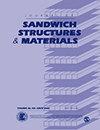夹层裸眼弯曲试验的发展与评价
IF 2.8
3区 材料科学
Q1 ENGINEERING, MECHANICAL
引用次数: 0
摘要
开发了一种开孔弯曲试验方法来评估夹层复合材料在弯曲载荷下的缺口敏感性。该测试方法最近被标准化为ASTM D8453,使用当前的长梁四点弯曲夹具,在标准样品中增加了一个位于中心的开口通孔。先前的研究已经确定了一种裸眼直径,它可以最大限度地减少有限宽度效应,同时在统计上显著降低强度。有限元分析的重点是量化裸眼应力集中与载荷跨度长度、孔位置公差以及试样和夹具错位之间的相互作用。研究了由于大挠度引起的非线性几何结构的影响,并规定了线性几何结构假设的限值。所研究的夹层结构由Nomex蜂窝芯和具有一定材料正交比的碳/环氧树脂面板层压板组成。进行了一系列机械测试,以评估拟议的试样设计以及现有的测试夹具和程序。进行第一组实验以评估缺口强度对载荷跨度长度的敏感性。第二组实验评估了不同堆芯密度和厚度的影响。本文章由计算机程序翻译,如有差异,请以英文原文为准。
Development and evaluation of the sandwich open-hole flexure test
An open-hole flexure test method has been developed to assess the notch sensitivity of sandwich composites under flexural loading. This test method, recently standardized as ASTM D8453, utilizes the current long beam four-point flexure fixture with the addition of a centrally-located open through-hole in the standard specimen. Previous research has identified an open-hole diameter that minimized finite-width effects while producing a statistically significant reduction in strength. Finite element analyses focused on quantifying interaction between the open-hole stress concentration and the load span length, hole location tolerance, and misalignment of the specimen and fixture. The effect of non-linear geometry due to large deflection was investigated and limits prescribed for linear geometry assumptions to remain valid. The sandwich configurations investigated consisted of a Nomex honeycomb core and carbon/epoxy facesheet laminates with a range of material orthotropy ratios. A series of mechanical tests were performed to evaluate the proposed specimen design, and the existing test fixture and procedure. The first set of experiments were performed to assess the notched strength sensitivity to the load span length. A second set of experiments assessed the effect of different core densities and thicknesses.
求助全文
通过发布文献求助,成功后即可免费获取论文全文。
去求助
来源期刊

Journal of Sandwich Structures & Materials
工程技术-材料科学:表征与测试
CiteScore
9.60
自引率
2.60%
发文量
49
审稿时长
7 months
期刊介绍:
The Journal of Sandwich Structures and Materials is an international peer reviewed journal that provides a means of communication to fellow engineers and scientists by providing an archival record of developments in the science, technology, and professional practices of sandwich construction throughout the world. This journal is a member of the Committee on Publication Ethics (COPE).
 求助内容:
求助内容: 应助结果提醒方式:
应助结果提醒方式:


